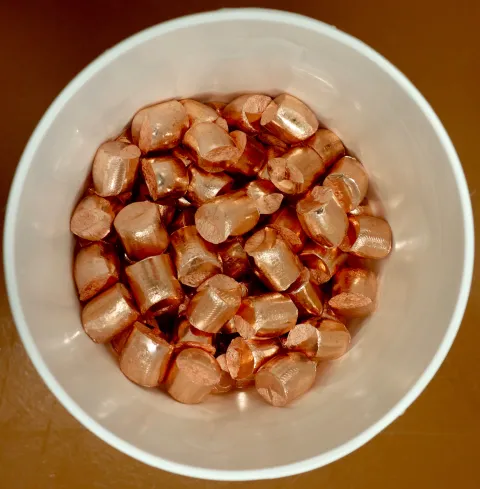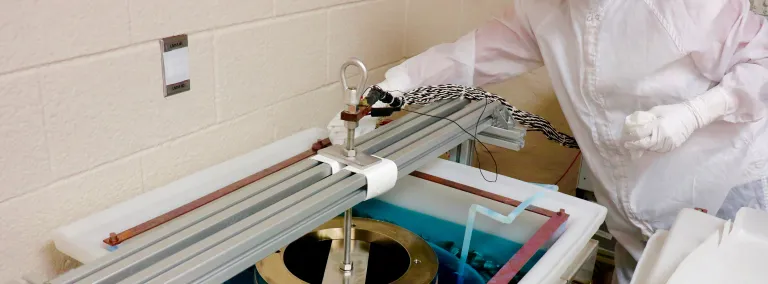Electroforming (again) on the 4850
What do you do when your experiment requires the world’s purest copper?
Give your copper nuggets a bath. But not just any bubble bath will do. This copper requires a long soak in a dilute sulfuric acid bath. Although the copper nuggets are already very pure—99.999 percent, to be exact—there may be traces of uranium, thorium and radioisotopes like Cobalt-60, all of which could cause background noise in sensitive physics experiments.
For five years, researchers with the Majorana Demonstrator Project grew ultra-pure copper for an ultra-quiet experiment on the 4850 Level at Sanford Lab. Now, the collaboration is preparing for future, ultra-sensitive experiments that will continue the search for a rare type of radioactive decay called neutrino-less double beta decay. Its discovery could explain the imbalance between matter and anti-matter in the universe—and, therefore, why we exist at all.
To prepare for the larger experiments, researchers recently began the electroforming process again.
“This is a long process, so we’re getting a head start in anticipation of the LEGEND experiments,” said Cabot-Ann Christofferson, task leader of electroforming for the LEGEND (Large Enriched Germanium Experiment for Neutrinoless ββ Decay), the next generation neutrinoless double-beta decay experiment.
The LEGEND collaboration was formed a year ago and includes members of the Majorana collaboration, the GERDA (GERmanium Detector Array) collaboration, and other researchers in this field.
Bath Time
The electroforming process, began in early June 2018 and will continue through 2021. A mile underground, two waist-high cubic baths silently growing the world’s purest copper. The collaboration will add a third.
The process works like this:
Mandrels weighing up to 60 pounds each are lowered into the center of the sulfuric acid bath and surrounded by nearly one ton of copper nuggets that have been double-etched in nitric acid. An electrical current is run through the mandrel, which attracts the copper ions, causing the copper to accumulate on the surface of the mandrel. The mandrels stay in the solution for more than a year, depending on the thickness required. It's a process that requires constant upkeep.
“The electroforming process creates such pure copper—a percentage with so many trailing nines—it couldn’t even be measured at the onset of the experiment in 2011,” said Christofferson, a chemist research scientist at the South Dakota School of Mines & Technology (SD Mines). “Today, the technology is so advanced, we can measure purity to parts per quadrillion (or 10-15)!”
Once the sulfuric acid dissolves the nuggets, the electric current pulls the copper, atom by atom onto the mandrel. This process slowly forms a layer of ultra-pure copper until it reaches the desired thickness.
How slowly? At a rate of one millimeter per month.
“The first delivery of copper will be 16 months from now,” Christofferson said. “At that point, there will be over one hundred pounds of copper encasing each mandrel. After that, we will start the bath again. In three years, with multiple baths running, we will have produced hundreds of pounds of copper.”
Researchers remove the copper from the mandrels and the copper is then machined and taken to Oak Ridge National Lab before being shipped in a special container to Gran Sasso National Laboratory (LNGS) in the Apennine Mountains of Italy, where the first iteration of LEGEND (LEGEND 200) will be built.
Christofferson and her team are quite familiar with the electroforming process—she ran multiple baths from July 2011 to April 2016, in preparation for the Majorana Demonstrator. At the time, the process took place at the Ross Campus, just a kilometer away from the current electroforming lab.
“Over the course of six years, we’ve learned a thing or two about how we could run the electroforming process better,” Christofferson said. “We implemented those changes and are excited to move forward.”

Copper nuggets before being placed in the electroforming baths. These have already been triple-etched in nitric acid.
Photo by Erin Broberg
The Purpose
The electroformed, ultra-pure copper is just one more significant detail in an experiment laden with significant details. The Majorana Demonstrator was built a mile underground, inside a class 100 clean room. The 44 kilograms of enriched and natural germanium detectors are encased in a six-layered shield that includes 2-inch thick ultra-pure copper plates, commercial copper plates, a 40-ton lead castle. The goal was to demonstrate the ability to create a quiet enough environment to justify scaling up to a ton-scale experiment.
With the experiment operating and taking data, the team is well on its way to achieving its goals, as did the GERDA experiment at LNGS. Together, these two experiments have the lowest background of any neutrinoless double-beta decay experiments in the world. Ideally, the LEGEND collaboration will combine the best of each experiment, Christofferson said.
The best of Majorana includes the ultra-pure copper, while GERDA demonstrated the benefit of an active shield—a tank of liquid argon—surrounding the detector.
“When something passes through GERDA’s argon tank, researchers can identify and exclude it,” Christofferson said. “LEGEND will adopt this active shielding, which is more practical compared to our layers of lead bricks, especially given LEGEND’s projected size.”
